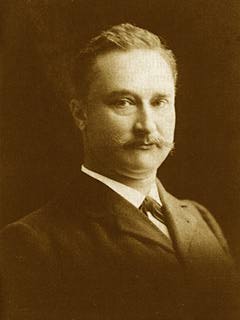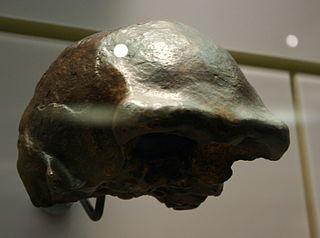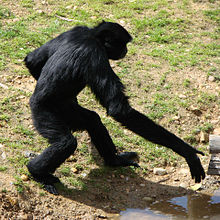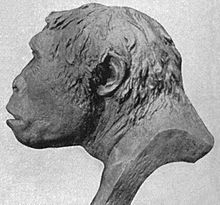
Marie Eugène François Thomas Dubois was a Dutch paleoanthropologist and geologist. He earned worldwide fame for his discovery of Pithecanthropus erectus, or "Java Man". Although hominid fossils had been found and studied before, Dubois was the first anthropologist to embark upon a purposeful search for them.

Meganthropus is an extinct genus of non-hominin hominid ape, known from the Pleistocene of Indonesia. It is known from a series of large jaw and skull fragments found at the Sangiran site near Surakarta in Central Java, Indonesia, alongside several isolated teeth. The genus has a long and convoluted taxonomic history. The original fossils were ascribed to a new species, Meganthropus palaeojavanicus, and for a long time was considered invalid, with the genus name being used as an informal name for the fossils.

Solo Man is a subspecies of H. erectus that lived along the Solo River in Java, Indonesia, about 117,000 to 108,000 years ago in the Late Pleistocene. This population is the last known record of the species. It is known from 14 skullcaps, two tibiae, and a piece of the pelvis excavated near the village of Ngandong, and possibly three skulls from Sambungmacan and a skull from Ngawi depending on classification. The Ngandong site was first excavated from 1931 to 1933 under the direction of Willem Frederik Florus Oppenoorth, Carel ter Haar, and Gustav Heinrich Ralph von Koenigswald, but further study was set back by the Great Depression, World War II and the Indonesian War of Independence. In accordance with historical race concepts, Indonesian H. erectus subspecies were originally classified as the direct ancestors of Aboriginal Australians, but Solo Man is now thought to have no living descendants because the remains far predate modern human immigration into the area, which began roughly 55,000 to 50,000 years ago.

Homo is a genus of great ape that emerged from the genus Australopithecus and encompasses the extant species Homo sapiens and a number of extinct species classified as either ancestral or closely related to modern humans. These include Homo erectus and Homo neanderthalensis. The oldest member of the genus is Homo habilis, with records of just over 2 million years ago. Homo, together with the genus Paranthropus, is probably most closely related to the species Australopithecus africanus within Australopithecus. The closest living relatives of Homo are of the genus Pan, with the ancestors of Pan and Homo estimated to have diverged around 5.7-11 million years ago during the Late Miocene.

Sangiran is an archaeological excavation site in Java in Indonesia. According to a UNESCO report (1995) "Sangiran is recognized by scientists to be one of the most important sites in the world for studying fossil man, ranking alongside Zhoukoudian (China), Willandra Lakes (Australia), Olduvai Gorge (Tanzania), and Sterkfontein, and more fruitful in finds than any of these."

Sinanthropus is an archaic genus in the scientific classification system to which the early hominid fossils of Peking man, Lantian Man, Nanjing Man, and Yuanmou Man were once assigned. All of them have now been reclassified as Homo erectus, and the genus Sinanthropus is disused. Beginning in the year 1928 to the year 1937, 14 fragmented skulls belonging to the hominids were found in various locations in China. Peking and Chou K’ou-tien are two notable places with fossils found. It has been noted by researchers that it is likely that the found fragmented skulls were brought to the cave after being severed from the bodies they belonged to. This is very likely, because most of the found pieces are teeth and jaws. Some skulls are missing large parts which indicates separation before they were fossilized, not the loss of pieces due to fossilization process.

Gustav Heinrich Ralphvon Koenigswald was a German-Dutch paleontologist and geologist who conducted research on hominins, including Homo erectus. His discoveries and studies of hominid fossils in Java and his studies of other important fossils of south-eastern Asia firmly established his reputation as one of the leading figures of 20th-century paleo-anthropology.
Human taxonomy is the classification of the human species within zoological taxonomy. The systematic genus, Homo, is designed to include both anatomically modern humans and extinct varieties of archaic humans. Current humans have been designated as subspecies Homo sapiens sapiens, differentiated, according to some, from the direct ancestor, Homo sapiens idaltu.

Trinil is a palaeoanthropological site on the banks of the Bengawan Solo River in Ngawi Regency, East Java Province, Indonesia. It was at this site in 1891 that the Dutch anatomist Eugène Dubois discovered the first early hominin remains to be found outside of Europe: the famous "Java Man" specimen.

Sangiran 2 is a fossilized upper cranium of a Homo erectus. It was discovered in Sangiran, Indonesia by G.H.R. von Koenigswald in 1937.

Homo erectus is an extinct species of archaic human from the Pleistocene, with its earliest occurrence about 2 million years ago. Its specimens are among the first recognizable members of the genus Homo.

The Hominidae, whose members are known as the great apes or hominids, are a taxonomic family of primates that includes eight extant species in four genera: Pongo ; Gorilla ; Pan ; and Homo, of which only modern humans remain.

Margarethe Lenore Selenka, also known as Margarethe Zelenka, was a German zoologist, anthropologist, feminist and pacifist. She researched apes and led scientific expeditions to the Dutch East Indies.

The Mojokerto child, also known as Mojokerto 1 and Perning 1, is the fossilized skullcap of a juvenile early human. It was discovered in February 1936 near Mojokerto by a member of an excavation team led by Ralph von Koenigswald. Von Koenigswald first called the specimen Pithecanthropus modjokertensis but soon renamed it Homo modjokertensis because Eugène Dubois – the discoverer of Java Man, which was then called Pithecanthropus erectus – disagreed that the new fossil was a Pithecanthropus. The skullcap is now identified as belonging to the species Homo erectus.

The terms Anthropopithecus and Pithecanthropus are obsolete taxa describing either chimpanzees or archaic humans. Both are derived from Greek ἄνθρωπος and πίθηκος, translating to "man-ape" and "ape-man", respectively.
The Trinil Fauna is a biostratigraphic faunal assemblage composed from several Javanese sites by Ralph von Koenigswald. Von Koenigswald assigned the early hominid fossils Java Man to the Trinil Fauna after discovering the main fossil of Java Man, a skullcap catalogued as "Trinil 2", in the same geological horizon.
The Trinil H. K. Fauna, or Trinil Haupt Knochenschicht Fauna is a biostratigraphic faunal assemblage. It is another interpretation of the collection of fossils gathered by Eugène Dubois at Trinil, where he discovered the early hominid fossils of Java Man. It was proposed in the 1980s a group of Dutch paleontologists to reassess the date of the layer in which Java Man was found.

The region of Southeast Asia is considered a possible place for the evidence of archaic human remains that could be found due to the pathway between Australia and mainland Southeast Asia, where the migration of multiple early humans has occurred out of Africa. One of many pieces of evidence is of the early human found in central Java of Indonesia in the late 19th century by Eugene Dubois, and later in 1937 at Sangiran site by G.H.R. van Koenigswald. These skull and fossil materials are Homo erectus, named Pithecanthropus erectus by Dubois and Meganthropus palaeojavanicus by van Koenigswald. They were dated to c. 1.88 and 1.66 Ma, as suggested by Swisher et al. by analysis of volcanic rocks.

"Missing link" is a hypothetical or recently-discovered transitional fossil. It is often used in popular science and in the media for any new transitional form. The term originated to describe the hypothetical intermediate form in the evolutionary series of anthropoid ancestors to anatomically modern humans (hominization). The term was influenced by the pre-Darwinian evolutionary theory of the Great Chain of Being and the now-outdated notion (orthogenesis) that simple organisms are more primitive than complex organisms.
The Pseudodon shell DUB1006-fL or Pseudodon DUB1006-fL is a fossil freshwater shell of Pseudodon vondembuschianus trinilensis found at Trinil, Java, Indonesia. The shell has a zigzag engraving supposedly made by Homo erectus, which could be the oldest known anthropogenic engraving in the world.























